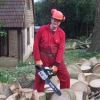Here it is: Mud.
Well, actually, quite refined mud. But still... Water-based, ceramic (pottery) clay is cheap, reusable and with it you can save yourself a lot of carving time and trouble. A search online ('pottery supplies', sculpture supplies' etc) will trawl out lots of sources.
In this lesson I look at the types of clay I use and you'll see that I prefer a clean, lighter, more kaolin-based clays for modelling, rather than the heavier, red earthenware sort. It seems to me that can I see the shadows better.

| 11 October 2019 16:25
Imran - If I need to keep a model for some while, I let it slowly harden. In other words I gradually let it dry out as it's exposed to air. It depends a little on the construction as to what happens: Best scenario, which results from a hollow, rag-filled model with fairly uniform clay thickness, the model will not crack and it ends up dry for ever. Worse scenario, it starts to crack and fall apart - it is only mud after all. And of course there is a range in between. If the model starts to crack in an undesirable way, I go back to spraying with water and covering it.

| 09 October 2019 18:46
Chris. In your clay modeling video you demonstrate that as you are modelling with clay one has to keep it wet (lets say one plans to cont. modeling for eg the next morning cover it with wet cloth etc). What should one do once the modeling is complete, and wood is being carved (days weeks etc for the carving). At this stage in order to preserve the model should one let it dry in room air? or does it still need to be kept moist? thanks

| 27 October 2016 11:27
Chris,
Thank you for the reply. It is worthy of framing.

| 27 October 2016 11:13
Robert - I often think we learn not in a straight line but more like a spiral staircase: returning again but at a higher level than before. (Hopefully!)
Most of all it's about keeping going. Woody Allen said once, "95% of success is showing up".
Don't forget to add your work to the Members Gallery!

| 23 October 2016 12:37
After being enrolled in this site for well over a year I've learned to go back and review the basics when my carving is not progressing well.
I've not followed the advice on modeling because I was using oil based clay and found it unstable to hold shapes. After viewing this video I've switched to the gray air dry the you recommend and it as you say fun.
Much less expensive than oil based and far less expensive than wasting good carving wood. $15.00 US for 25# box at local teachers art store. Watch twice and carve once.

| 12 January 2016 09:34
Hi Chris, could I you use air drying clay as a alternative ?

| 12 January 2016 09:26
Tobias - I'm not sure what you mean by 'air drying clay' but assuming whatever you have your eye on is pliable enough to model with, the best thing is just to give it a go and see... I'm all for experimenting!

| 05 January 2015 14:51
Dermot - I never mix the 'normal' clay with the one that has the glass fibres in it, but you could at a pinch if you didn't have enough of the one sort. The glass fibres bind the clay and resist cracking when the clay dries; ceramic or modelling clays will tend to crack as they shrink, and it rather defeats the 'purpose'.of the clay with glass fibres if you mix. You can resist cracking in normal clay if you make the forms hollow - having rags or paper in the middle for example - so the clay doesn't fir itself as it shrinks more evenly.

| 04 January 2015 07:21
Chris, of the two types you use, can you mix them when modelling?

| 20 October 2014 14:43
Thomas - For sure you can a modelling clay in the USA, though you might have to pay delivery - it's a big country! Just Google around ceramic or modelling clay and see what you get. How about the 'Minnesota Clay Company' for example: www.mnclay.com? They do a stoneware clay that looks good. Call them and I'm sure they will be very helpful.

| 17 October 2014 00:48
It doesn't look like I can obtain these two clays in the USA.

| 18 December 2013 23:37
The synthetic type modelling products often require heating with a hair dryer or even in a microwave. They regain hardness as they cool down which can also be handy depending on how you sculpt or what you are sculpting. It also allows you to heat up some metal tools to work into the piece which can be great for details. All that being said, I like my mud best.

| 06 March 2013 09:18
I really looking forward to see more video on modeling in clay !

| 28 February 2013 12:18
Helpful distinctions between the 3 types.